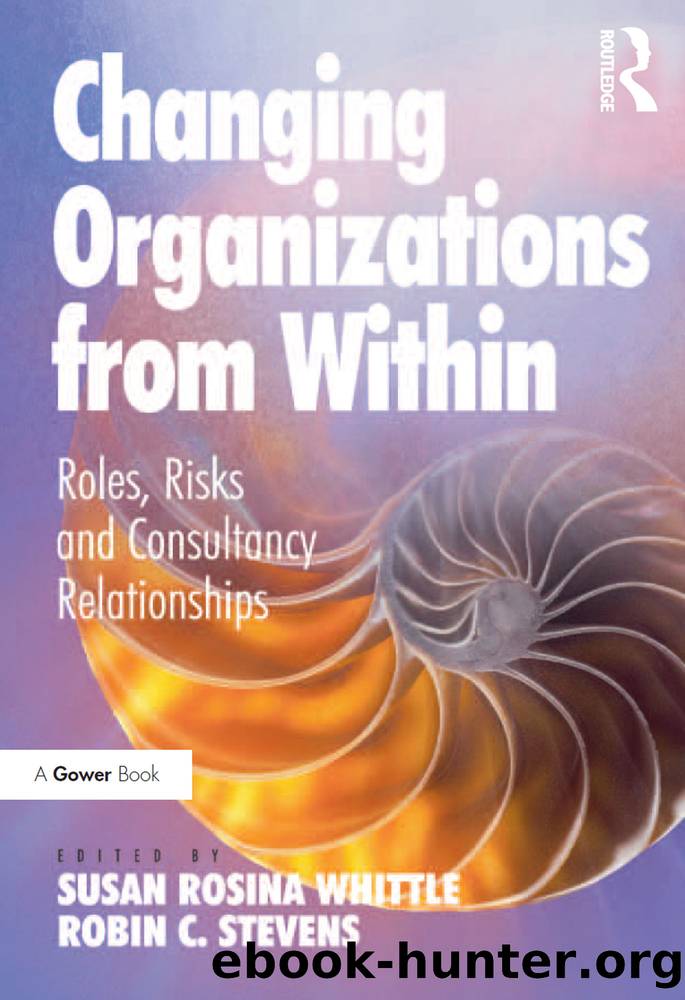Changing Organizations from Within by unknow

Author:unknow
Language: eng
Format: epub
Publisher: Taylor & Francis Group
Published: 2016-08-15T00:00:00+00:00
5
Quick, Quick, Slow: Time and Timing in Organizational Change
Susan Rosina Whittle
DOI: 10.4324/9781315571263-6
Introduction
Itâs all too easy to think of time as a constant, flowing past endlessly at the same rate. Billions of years ago, the earth had a five hour day but the impact of an asteroid, that created the moon and its gravitational field, has been slowing down our planet ever since. The 24-hour day is only relevant to our time, the present. Now days are getting shorter again, as the moon moves away from the earth. In the future, a 24-hour day will seem bizarre. There is no absolute measure of time (Vimal and Davia 2010). When people in organizations think and behave as if time is a given, they share assumptions about what happens when and at what pace. These time logics (Reay and Hinings 2009) indicate that time is an aspect of the culture of that organization that people are attached to. Time logics can preclude thinking and behaving in different and more effective ways (Schein 1985).
An experienced and well respected doctor of public health had led a strategic restructuring of community health services across a city. This relocated nursery nurses, health visitors, and others away from surgeries provided by local family doctors into locality-based groups, resourced according to levels of deprivation and indicators of community (ill) health. The changes ran into difficulty when the local doctors realized they would lose some of their staff and might have to take on more service provision themselves. They did not feel fully consulted on the restructuring, which they accused of being policy-driven rather than evidence-based. They felt things had not been handled in the right order or at the right pace. They were hurried. Inter-professional relations nosedived and a sensible strategy became a political battlefield. If only the implementation rewind button could be pressed back a couple of months, when some concerns were expressed but side-lined by prioritizing the need to meet end of year reporting cycles. The doctor didnât want to spend any more time on this and brought in an external consultant.
When we talk about the work of crafting organizational change, time is often an issue. There is never enough time. Decisions are taken too slowly or too quickly. The planning workshop was hurried to meet the contract deadline. A feedback presentation is brought forward, because the CEO wonât be around next week. Things donât happen when agreed or there is obsessive clinging to the timing of events and actions as if to a life boat in a stormy sea. Blame can be directed at the client, who is accused of naive haste, or the consultant, willfully delaying the next phase of a change project. So why do time and pace rarely feature as significant factors in the literature on organizational change (Huy 2001)?
Orchestrating the sequencing, pace and tempo of interventions is a core competence for practitioners of organizational change. Whilst external consultants can develop this competence on the job, it is perhaps more difficult for internal
Download
This site does not store any files on its server. We only index and link to content provided by other sites. Please contact the content providers to delete copyright contents if any and email us, we'll remove relevant links or contents immediately.
Through Windows of Opportunity : A Neuroaffective Approach to Child Psychotherapy by Marianne Bentzen; Susan Hart(889)
Overcoming ADHD Without Medication : A Guidebook for Parents and Teachers by Children and Natural Psychology Association for Youth; Children The Association for Youth(826)
Out of the Mainstream: Helping the Children of Parents with a Mental Illness by Loshak Rosemary;(821)
Delphi Collected Works of Sigmund Freud (Illustrated) by Sigmund Freud(580)
The Noom Mindset by Noom(555)
The 48 Laws of Mental Power: Overcoming Trauma and Building Mental Strength by Victor O. Carl(485)
The Psychology of Media and Politics by George Comstock & Erica Scharrer(451)
MANIPULATION & MIND CONTROL: The Persuasion Collection: Dark Psychology Secrets, Analyze & Influence People with Nlp. How to learn Reading Friends and Develop Body Language Skills. by ROBERT TOWER(441)
Sigmund Freud by Janet Sayers;(415)
It's nobody's fault: new hope and help for difficult children and their parents by Harold Koplewicz(404)
Behold the Monster by Jillian Lauren(404)
The Hypnotic Coach: A Conversational Hypnotherapy Tool Kit by Marion Jess(394)
Directions in Technical Writing and Communication by Gould Jay R.;(385)
THE PSYCHOLOGY OF ENTREPRENEURSHIP; New Perspectives by Michael M. Gielnik; Melissa S. Cardon; Michael Frese(360)
Mastering Flow: Perform Better, Experience More Joy, and Live a Happier Life by Nils Salzgeber(351)
Totem and Taboo: Some Points of Agreement between the Mental Lives of Savages and Neurotics by Sigmund Freud(346)
Positive Psychology Across the Lifespan; An Existential Perspective by Piers Worth(338)
Mind Hacking Secrets and Unlimited Memory Power: 2 Books in 1: Learn How to Improve Your Memory & Develop Fast, Clear Thinking in 2 Weeks + 42 Brain Training Techniques & Memory Improvement Exercises by Sharp Scott(334)
The Modern Young Man's Guide to Manhood by Wayne Walker(326)
